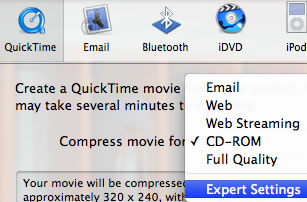A. Do this once on a master MacBook - teacher machine. Download and install mp3 audio converter. Express Scribe needs mp3 audio files in order to work.
- Downloand and install Switch - a free audio conversion tool – http://www.nch.com.au/switch/index.html
B. Make a full iMovie file copy onto the external hard-drive. You will use this external hard-drive version to: serve as the permanent archive, make the audio-only files for transcribing, and making any compressed movies for distribution. This assumes you captured the entire interview on iMovie HD and it lives on a laptop.
- Connect laptop to external hard-drive and make sure it mounts/loads
- Locate the iMovie HD file on the laptop used for the interview capture and drag to location on the external hard-drive - the transfer process will take several minutes.
C. Make the audio-only files to be used for transcription
 Open the iMovie HD interview file on the external hard-drive Open the iMovie HD interview file on the external hard-drive- Select all the movie icon files in the top "clips pane" and drag to the timeline editor at the bottom. Only items in the bottom timeline editor are exported in the export process.
- Do the following:
- choose File > Export
- choose the Quicktime icon
- choose "Expert Settings" in the "Compress Movie for" pull-down
- click "Share"
- Do the following:
- Choose the "Sound to Wav"
- name the file (eg., 'butler-audio-only")
- set destination to "Desktop"
- click "save" - this may now take several minutes to complete.
- Once fully converted, launch Switch, drag the audio-only .wav file from above and convert to mp3. This is the file you will now use to distribute for all future transcription.
D. Distribute the "audio-only" file to computers for transcribing.
- Drag-and-drop onto flash drive or other storage media
- Pull into transcribing computers - be sure to create a sensible folder-structure to ease direction to students
|

